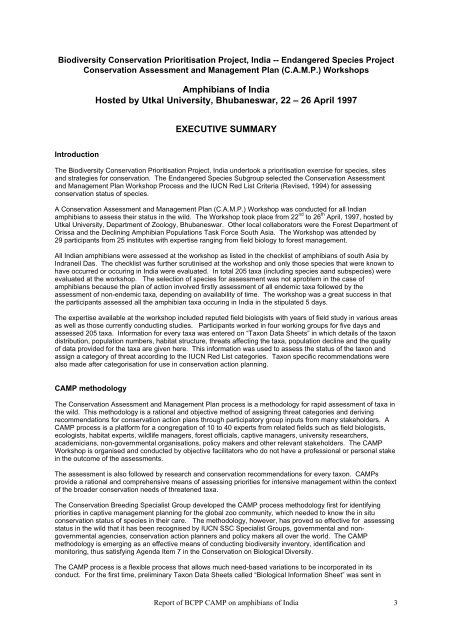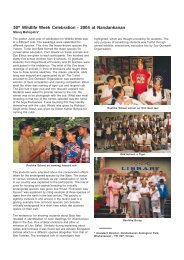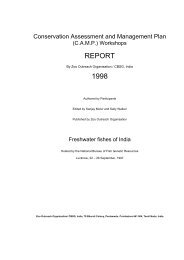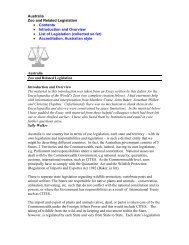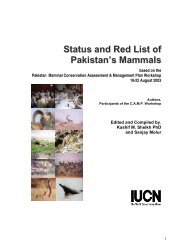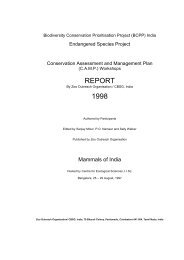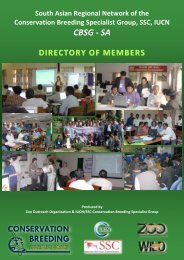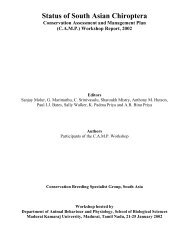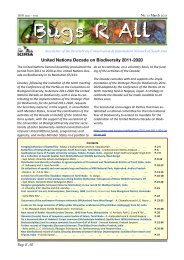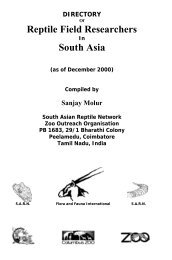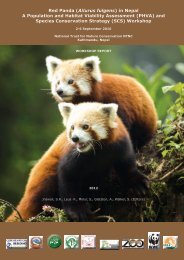BCPP CAMP Amphibian Exec Summ 1998.pdf - Zoo Outreach ...
BCPP CAMP Amphibian Exec Summ 1998.pdf - Zoo Outreach ...
BCPP CAMP Amphibian Exec Summ 1998.pdf - Zoo Outreach ...
Create successful ePaper yourself
Turn your PDF publications into a flip-book with our unique Google optimized e-Paper software.
Biodiversity Conservation Prioritisation Project, India -- Endangered Species ProjectConservation Assessment and Management Plan (C.A.M.P.) Workshops<strong>Amphibian</strong>s of IndiaHosted by Utkal University, Bhubaneswar, 22 – 26 April 1997EXECUTIVE SUMMARYIntroductionThe Biodiversity Conservation Prioritisation Project, India undertook a prioritisation exercise for species, sitesand strategies for conservation. The Endangered Species Subgroup selected the Conservation Assessmentand Management Plan Workshop Process and the IUCN Red List Criteria (Revised, 1994) for assessingconservation status of species.A Conservation Assessment and Management Plan (C.A.M.P.) Workshop was conducted for all Indianamphibians to assess their status in the wild. The Workshop took place from 22 nd to 26 th April, 1997, hosted byUtkal University, Department of <strong>Zoo</strong>logy, Bhubaneswar. Other local collaborators were the Forest Department ofOrissa and the Declining <strong>Amphibian</strong> Populations Task Force South Asia. The Workshop was attended by29 participants from 25 institutes with expertise ranging from field biology to forest management.All Indian amphibians were assessed at the workshop as listed in the checklist of amphibians of south Asia byIndraneil Das. The checklist was further scrutinised at the workshop and only those species that were known tohave occurred or occuring in India were evaluated. In total 205 taxa (including species aand subspecies) wereevaluated at the workshop. The selection of species for assessment was not aproblem in the case ofamphibians because the plan of action involved firstly assessment of all endemic taxa followed by theassessment of non-endemic taxa, depending on availability of time. The workshop was a great success in thatthe participants assessed all the amphibian taxa occuring in India in the stipulated 5 days.The expertise available at the workshop included reputed field biologists with years of field study in various areasas well as those currently conducting studies. Participants worked in four working groups for five days andassessed 205 taxa. Information for every taxa was entered on “Taxon Data Sheets” in which details of the taxondistribution, population numbers, habitat structure, threats affecting the taxa, population decline and the qualityof data provided for the taxa are given here. This information was used to assess the status of the taxon andassign a category of threat according to the IUCN Red List categories. Taxon specific recommendations werealso made after categorisation for use in conservation action planning.<strong>CAMP</strong> methodologyThe Conservation Assessment and Management Plan process is a methodology for rapid assessment of taxa inthe wild. This methodology is a rational and objective method of assigning threat categories and derivingrecommendations for conservation action plans through participatory group inputs from many stakeholders. A<strong>CAMP</strong> process is a platform for a congregation of 10 to 40 experts from related fields such as field biologists,ecologists, habitat experts, wildlife managers, forest officials, captive managers, university researchers,academicians, non-governmental organisations, policy makers and other relevant stakeholders. The <strong>CAMP</strong>Workshop is organised and conducted by objective facilitators who do not have a professional or personal stakein the outcome of the assessments.The assessment is also followed by research and conservation recommendations for every taxon. <strong>CAMP</strong>sprovide a rational and comprehensive means of assessing priorities for intensive management within the contextof the broader conservation needs of threatened taxa.The Conservation Breeding Specialist Group developed the <strong>CAMP</strong> process methodology first for identifyingpriorities in captive management planning for the global zoo community, which needed to know the in situconservation status of species in their care. The methodology, however, has proved so effective for assessingstatus in the wild that it has been recognised by IUCN SSC Specialist Groups, governmental and nongovernmentalagencies, conservation action planners and policy makers all over the world. The <strong>CAMP</strong>methodology is emerging as an effective means of conducting biodiversity inventory, identification andmonitoring, thus satisfying Agenda Item 7 in the Conservation on Biological Diversity.The <strong>CAMP</strong> process is a flexible process that allows much need-based variations to be incorporated in itsconduct. For the first time, preliminary Taxon Data Sheets called “Biological Information Sheet” was sent inReport of <strong>BCPP</strong> <strong>CAMP</strong> on amphibians of India 3
advance to all known amphibian researchers in India and all other people listed in the invitee list. Along with theBiological Information Sheet was also mailed the <strong>CAMP</strong> Manual to help the respondants in understanding theconcept and objective of the workshop and the IUCN categories. The Biological Information Sheet is a modifiedTaxon Data Sheet that is more self-explanatory and does not require the help of an interpretive manual to befilled. This exercise helped in gathering information from different areas about different taxa before hand and thesheets were also utilised extensively at the workshop by participants for information that was not available withinthe context of the workshop. The sheets therefore provided the means of representation for participants whocould not attend the workshop for some reason.ResultsIndian amphibians, which are about 205 taxa in number have a very high representation of endemics. Nearlysixty-three percent (63%) of the amphibians are endemic to India. Western Ghats is the richest region in India interms of amphibian endemicity. Ninety-three taxa are endemic to this biogeographic region with 2 more taxasharing their distribution with adjacent areas. Northeastern India, which has a very high diversity amongamphibians does not have many endemics within the Indian context because of the jagged political boundary ofthe country. Though restricted in their distribution in this region, locations of many amphibians are found outsideIndia thereby making them Indian political non-endemics. The case is similar in northern and northwestern Indiawith many species ranging across neighbouring countries such as Pakistan, Nepal, Afghanistan and Tibet. Agraph depicting amphibian distribution is given in the main report.Eighty-seven endemic taxa are threatened according to the assessment at the workshop, based on the 1994IUCN Red list categories. The high percentage of endemic taxa being threatened is due to restricted distributionof these taxa along with other man-induced threats to their wellbeing. <strong>Amphibian</strong> studies in India is still at its<strong>Amphibian</strong>s of IndiaIndian Endemics129 (63%)Non-endemics76 (37%)Number of Indian amphibians = 205infancy stage since much more information regarding distribution, population dynamics and threats are required.The reasons for global declines in amphibians due to exessive UV radiation and fungi are yet to be determinedamong amphibians in India. Their decline (if any) due to these factors has not yet been established in India.Threats perceived to Indian amphibians are more physical in nature, such as those by habitat destruction,fragmentation, agricultural practices, pollution, pesticides and other kinds of human interference.Categorisation of taxa was done according to the 1994 IUCN Red Liast categories. For a taxon to bethreatened, any one of the five criteria within the categories has to be satisfied. These criteria or factors that areused in a categorisation of threat are 1. Population reduction; 2. Restricted distribution; 3. Population size; 4.Number of mature individuals and 5 Probability of extinction. The degree of threat depending on each or any ofthese five criteria determines the threat category.One of the major outcomes of this workshop was the post-assessment research and managementrecommendations for every taxon. Participants identified lacunae areas that need prioritisation and this isindicated in the recommendation section. Survey and monitoring are the most frequently recommendedresearch and management tools for understanding distribution and trends of amphibian populations. The4Report of <strong>BCPP</strong> <strong>CAMP</strong> on amphibians of India
workshop was also an ideal forum to discuss controversial issues such as taxonomy and nomenclature of Indianamphibians. In the recent years, a few taxonomists have suggested frequent changes in generic names ofsome amphibians in India, which has led to confusion among field biologists. This issue was sorted during theworkshop in a special issue working group. Other issues which were discussed separately include educationand awareness, research priorities and captive breeding. The reports of each of these special issue workinggroup is included in the main report.Status of amphibians of IndiaVulnerable42 (32.5%)EndemicsEndangered24 (18.6%)Lower Risknear threatened36 (47.3%)Non-endemicsVulnerable 4 (5.2%)Endangered18 (23.6%)CriticallyEndangered10 (7.7%)NotEvaluated2 (1.5%)NotEvaluated1 (1.3%)Lower Risknear threatened21 (16.2%)Lower Riskleast concern2 (1.5%)Data Deficient28 (21.7%)Lower Riskleast concern6 (7.9%)Data Deficicent11 (14.4%)Number of Indian endemics = 129IUCN Assessment = GlobalNumber of non-endemics = 76IUCN Assessment = NationalTable 1. Alphabetical list of <strong>Amphibian</strong> taxa assessed.Species Family IUCN CriteriaINDIAN ENDEMICSAnsonia kamblei Ravichandan & Pillai Bufonidae DD --Ansonia ornata Günther Bufonidae EN (B1, 2c)Ansonia rubigina Pillai & Pattabhiraman Bufonidae EN (B1, 2c, 3b)Bufo abatus Ahl Bufonidae DD --Bufo beddomii Günther Bufonidae LRlc --Bufo brevirostrisRao Bufonidae DD --Bufo camortensis Mansukhani & Sarkar Bufonidae VU (D2)Bufo hololius (Günther) Bufonidae LR-nt --Bufo koynayensis Soman Bufonidae EN (B1, 2c)Bufo parietalis Boulenger Bufonidae LRnt --Bufo silentvalleyensis Pillai Bufonidae VU (D2)Bufoides meghalayanus (Yazdani & Chanda) Bufonidae CR (B1, 2abc)Chirixalus dudhwaensis Ray Rhacophoridae VU (D2)Euphlyctis ghoshi (Chanda) Ranidae EN (B1, 2abc)Gegeneophis carnosus (Beddome) Caeciliidae VU (B1, 2c)Gegeneophis fulleri (Alcock) Caeciliidae VU (B1, 2ac)Gegeneophis ramaswamii Taylor Caeciliidae EN (B1, 2c)Ichthyophis beddomei Peters Ichthyophiidae VU (A1ac; B1, 2c)Ichthyophis bombayensis Taylor Ichthyophiidae EN (B1, 2c)Ichthyophis longicephalus Pillai Ichthyophiidae VU (B1, 2c)Ichthyophis malabarensis Taylor Ichthyophiidae VU (B1, 2c)Ichthyophis peninsularis Taylor Ichthyophiidae VU (B1, 2c; D2)Ichthyophis sikkimensis (Taylor) Ichthyophiidae VU (B1, 2c)Ichthyophis subterrestris Taylor Ichthyophiidae VU (B1, 2c)Report of <strong>BCPP</strong> <strong>CAMP</strong> on amphibians of India 5
Species Family IUCN CriteriaIchthyophis tricolor Taylor Ichthyophiidae EN (B1, 2c)Indirana beddomii Günther Ranidae VU (A1ac)Indirana brachytarsus (Günther) Ranidae VU (B1, 2b)Indirana diplostictus (Günther) Ranidae VU (B1, 2c)Indirana gundia Dubois Ranidae DD --Indirana leithii (Boulenger) Ranidae LR-nt --Indirana leptodactylus (Boulenger) Ranidae VU (B1, 2c)Indirana semipalmatus (Boulenger) Ranidae VU (A1ac; B1, 2c)Indirana tenuilingua (Rao) Ranidae DD --Indotyphlus battersbyi Taylor Caeciliidae CR (B1, 2bc)Kaloula baleata ghoshi Cherchi Microhylidae VU (D2)Limnonectes andamanensis (Stoliczka) Ranidae LR-lc --Limnonectes brevipalmatas (Peters) Ranidae LR-nt --Limnonectes keralensis (Dubois) Ranidae LR-nt --Limnonectes khasiensis (Anderxon) Ranidae DD --Limnonectes mawlyndipi (Chanda) Rhacophoridae CR (B1, 2ac)Limnonectes mawphlangensis (Pillai & Chanda) Ranidae CR (B1, 2ac)Limnonectes murthii Pillai Ranidae EN (B1, 2c)Limnonectes mysorensis Rao Ranidae CR (B1, 2c)Limnonectes nilagirica (Jerdon) Ranidae EN (B1, 2c)Limnonectes sauriceps (Rao) Ranidae DD --Limnonectes shompenorum Das Ranidae EN (B1, 2abc)Megophrys robusta (Boulenger) Pelobatidae EN (B1, 2c)Melanobatrachus indicus Beddome Microhylidae VU (B1, 2c, 3c; D2)Micrixalus fuscus (Boulenger) Ranidae LR-nt --Micrixalus gadgili Pillai & Pattabiraman Ranidae EN (B1, 2c)Micrixalus nudis Pillai Ranidae VU (B1, 2c)Micrixalus phyllophilus (Jerdon) Ranidae VU (B1, 2c)Micrixalus saxicola (Jerdon) Ranidae LR-nt --Micrixalus silvaticus (Boulenger) Ranidae VU (B1, 2c)Micrixalus thampii Pillai Ranidae EN (B1, 2c)Microhyla chakrapani Pillai Microhylidae VU (D2)Nyctibatrachus aliciae Inger, Shaffer, Koshy & Bakde Ranidae VU (B1, 2c)Nyctibatrachus beddomii (Boulenger) Ranidae LR-nt --Nyctibatrachus deccanensis Dubois Ranidae VU (B1, 2c)Nyctibatrachus humayuni Bhaduri & Kripalani Ranidae EN (B1, 2c)Nyctibatrachus kempholeyensis (Rao) Ranidae DD --Nyctibatrachus major Boulenger Ranidae LR-nt --Nyctibatrachus minor Inger, Shaffer, Koshy & Bakde Ranidae VU (B1, 2c; D2)Nyctibatrachus sanctipalustris Rao Ranidae EN (B1, 2c)Nyctibatrachus sylvaticus Rao Ranidae DD --Pedostibes kempi (Boulenger) Bufonidae CR (B1, 2abc)Pedostibes tuberculosus Günther Bufonidae VU (B1, 2c)Philautus beddomii (Günther) Rhacophoridae VU (B1, 2c)Philautus bombayensis (Annandale) Rhacophoridae EN (B1, 2c)Philautus chalazodes Günther Rhacophoridae VU (B1, 2c; D2)Philautus charius Rao Rhacophoridae LR-nt --Philautus cherrapunjiae Roonwall & Kripalani Rhacophoridae EN (B1, 2ac)Philautus crnri Dutta Rhacophoridae DD --Philautus elegans Rao Rhacophoridae DD --Philautus flaviventris (Boulenger) Rhacophoridae DD --Philautus garo (Boulenger) Rhacophoridae CR (B1, 2bc)Philautus glandulosus (Jerdon) Rhacophoridae VU (B1, 2c)Philautus hassanensis Dutta Rhacophoridae DD --Philautus kempiae (Boulenger) Rhacophoridae CR (B1, 2abc)Philautus kottigeharensis Rao Rhacophoridae DD --Philautus leucorhinus (Lichtenstein & Martens) Rhacophoridae LR-nt --Philautus melanensis Rao Rhacophoridae DD --Philautus namdaphaensis Sarkar & Sanyal Rhacophoridae VU (B1, 2c; D2)Philautus narainensis Rao Rhacophoridae DD --Philautus nobeli (Ahl) Rhacophoridae DD --Philautus parkeri (Ahl) Rhacophoridae DD --6Report of <strong>BCPP</strong> <strong>CAMP</strong> on amphibians of India
Species Family IUCN CriteriaPhilautus pulcherimus (Ahl) Rhacophoridae VU (B1, 2c)Philautus shillongensis Pillai & Chanda Rhacophoridae CR (B1, 2abc)Philautus shyamrupus Chanda & Ghosh Rhacophoridae VU (B1, 2c; D2)Philautus signatus (Boulenger) Rhacophoridae VU (B1, 2c)Philautus swamianus Rao Rhacophoridae DD --Philautus temporalis Günther Rhacophoridae EN (B1, 2c)Philautus travancoricus (Boulenger) Rhacophoridae DD --Philautus variabilis (Günther) Rhacophoridae LR-nt --Phrynoglossus borealis (Annandale) Ranidae EN (B1, 2c)Polypedates cruciger (Blyth) Rhacophoridae VU (B1, 2c; D2)Polypedates insularis Das Rhacophoridae EN (B1, 2abc)Ramanella anamalaiensis Rao Microhylidae DD --Ramanella minor Rao Microhylidae DD --Ramanella montana Jerdon Microhylidae LRnt --Ramanella mormorata Rao Microhylidae VU (B1, 2bc; D2)Ramanella triangularis (Günther) Microhylidae VU (B1, 2c; D2)Rana aurantiaca (Boulenger) Ranidae LR-nt --Rana curtipes Jerdon Ranidae LR-nt --Rana danieli Pillai & Chanda Ranidae LR-nt --Rana garoensis Boulenger Ranidae EN (B1, 2abc)Rana khare (Kiyasetuo & Khare) Ranidae EN (B1, 2c)Rana malabarica Tschudi Ranidae LR-nt --Rana senchalensis Chanda Ranidae CR (B1, 2abc)Rana travancorica Annandale Ranidae DD --Rhacophorus calcadensis Ahl Rhacophoridae DD --Rhacophorus jerdonii (Günther) Rhacophoridae VU (B1, 2c; D2)Rhacophorus lateralis Boulenger Rhacophoridae EN (B1, 2c)Rhacophorus malabaricus Jerdon Rhacophoridae LR-nt --Rhacophorus namdaphaensis Sarkar & Sanyal Rhacophoridae VU (B1, 2c; D2)Rhacophorus naso Annandale Rhacophoridae DD --Rhacophorus pleurostictus (Günther) Rhacophoridae VU (B1, 2c)Rhacophorus taeniatus Boulenger Rhacophoridae LR-nt --Rhacophorus tuberculatus (Anderson) Rhacophoridae LRnt --Scutiger occidentalis Dubois Pelobatidae DD --Tomopterna leucorhynchus Rao Ranidae DD --Tomopterna parambikulamana Rao Ranidae DD --Tomopterna rufescens (Jerdon) Ranidae LR-nt --Uraeotyphlus malabaricus (Beddome) Uraeotyphlidae EN (B1, 2c)Uraeotyphlus menoni Annandale Uraeotyphlidae VU (B1, 2c; D2)Uraeotyphlus narayani Seshachar Uraeotyphlidae VU (B1, 2c)Uraeotyphlus oxyurus (Dumeril & Bibron) Uraeotyphlidae VU (B1, 2c)NON-ENDEMICSAmolops afghanus (Günther) Ranidae LR-nt --Amolops formosus (Günther) Ranidae LR-nt --Amolops gerbillus (Annandale) Ranidae LR-nt --Amolops monticola (Anderson) Ranidae EN (B1, 2bc)Bufo fergusonii (Boulenger) Bufonidae LR-lc --Bufo himalayanus (Günther) Bufonidae LR-nt --Bufo latastii (Boulenger) Bufonidae LR-lc --Bufo melanostictus (Schneider) Bufonidae VU (A1acd)Bufo microtympanum (Boulenger) Bufonidae LR-nt --Bufo stomaticus Lütken Bufonidae LR-nt --Bufo stuarti (Smith) Bufonidae LR-nt --Bufo viridis Laurenti Bufonidae DD --Chaparana sikimensis (Jerdon) Ranidae LR-nt --Chirixalus doriae Boulenger Rhacophoridae EN (B1, 2c)Chirixalus simus Annandale Rhacophoridae EN (B1, 2abc)Chirixalus vittatus (Boulenger) Rhacophoridae EN (B1, 2c)Euphlyctis cyanophlyctis (Schneider) Ranidae LR-nt --Euphlyctis hexadactylus (Lesson) Ranidae LR-nt --Hoplobatrachus crassus (Jerdon) Ranidae LR-nt --Report of <strong>BCPP</strong> <strong>CAMP</strong> on amphibians of India 7
Species Range Area No ofloc./ F%declineYear/gen.Pop.no.DataqualityThreats IUCN Crit.usedResearchrecommend.Capt.Breed.Lev. Diff.INDIAN ENDEMICSAnsonia kamblei B Unk 1 Unk Unk Unk 2 Unk DD - S, Lh, T, M, PP 3 UnkAnsonia ornata B C 2 Unk Unk Unk 2 I EN RD S, T, M, Lh, PP 2 UnkAnsonia rubigina B B 2, F Unk Unk Unk 2 I, L EN RD S, M, Lh 2 UnkBufo abatus Unk Unk 1 Unk Unk Unk 2, 5 Unk DD - S, L No UnkBufo beddomii D C >10 Unk Unk Unk 2 I LRlc - Lh No UnkBufo brevirostris Unk Unk Unk Unk Unk Unk 5 I DD - S, Lh No UnkBufo camortensis B C 5, F Unk Unk Unk 1 L, I LR-nt - T, S, M No UnkBufo koynayensis B C 2 Unk Unk Unk 2 I, L EN RD S, T, M, PP 2 UnkBufo parietalis D D >10, F Unk Unk Unk 2 L, Lf, I LRnt - S, Lh, M No UnkBufo silentvalleyensis A B 1 Unk Unk Unk 2 Unk VU NM S, T, M, PP 3 UnkBufoides meghalayanus A A 1 Unk Unk Unk 2 L, I CR RD S, Lh, M 2 UnkChirixalus dudhwaensis B C 1 Unk Unk Unk 2 Unk VU NM S, T No UnkEuphlyctis ghoshi B C 1 Unk Unk Unk 2 L EN RD S, Lh, T, M 2 UnkGegeneophis carnosus C D 6, F Unk Unk Unk 2 I VU RD S, Lh, T, M, PP 3 UnkGegeneophis fulleri C C 1 Unk Unk Unk 2, 5 L, I VU RD S, Lh No UnkGegeneophis ramaswamii B B 2 Unk Unk Unk 2 L, I EN RD S, Lh, T, M, PP 2 3Ichthyophis beddomei D C 8 20 10 >2500 1, 2 I, E, Pu, L, Lf VU PR, RD M, Hm 3 2Ichthyophis bombayensis B C 3, F Unk Unk Unk 2 E, L, I EN RD S, T, M, Lh, Lr, PP 2 UnkIchthyophis longicephalus C C 2 10, F Unk Unk Unk 2 L, Lf, I LR-nt - M, Lh, PP No UnkIndirana leptodactylus C C 10 Unk Unk Unk 2 L, Lf, I LR-nt - S, Lh, M, PP No UnkLimnonectes keralensis D D 7, F Unk Unk Unk 2 I, Pu, Lf LR-nt - Lh, S, M, T No UnkLimnonectes khasiensis Unk Unk 1 Unk Unk Unk 5 Unk DD - S, T, Lh No UnkReport of <strong>BCPP</strong> <strong>CAMP</strong> on amphibians of India 11
Species Range Area No of % Year/ Pop. Data Threats IUCN Crit. ResearchCapt. Lev. Diff.loc./ F decline gen. no. qualityused recommend. Breed.Philautus kempiae A A 1 Unk Unk Unk 5 L, I CR RD S, T, Lh, M 2 UnkPhilautus kottigeharensis Unk Unk 1 Unk Unk Unk 5 Unk DD - S, T, Lh No UnkPhilautus leucorhinus D D >10 Unk Unk Unk 2 L, I, Lf LR-nt - S, Lh, M No UnkPhilautus melanensis Unk Unk 1 Unk Unk Unk 5 Unk DD - S, T, Lh No UnkPhilautus namdaphaensis D C 1 Unk Unk Unk 2 L, I VU RD, NM S, Lh, M 3 UnkPhilautus narainensis Unk Unk 1 Unk Unk Unk 5 Unk DD - S, T, Lh No UnkPhilautus nobeli Unk Unk 1 Unk Unk Unk 2 Unk DD - S No UNKPhilautus parkeri Unk Unk 1 Unk Unk Unk 5 Unk DD - S No UnkPhilautus pulcherimus C C 6 Unk Unk Unk 2 I VU RD S, T, Lh, pp No UnkPhilautus shillongensis A A 1 Decl. Unk Unk 2 L, I CR RD S, Lh, M No UnkPhilautus shyamrupus D C 1 Unk Unk Unk 2 L VU RD, NM S, Lh, M No UnkPhilautus signatus C C 7 Unk Unk Unk 2 Pu VU RD S, T, PP No UnkPhilautus swamianus Unk Unk 1 Unk Unk Unk 5 Unk DD - S, T, Lh No UnkPhilautus temporalis C B 2 Unk Unk Unk 2 I EN RD S, Lh, M, T P UnkPhilautus travancoricus Unk Unk 1 Unk Unk Unk 5 Unk DD - S, T, PP No UnkPhilautus variabilis D D 10 Unk Unk Unk 2 I, L LR-nt - Lh, M, T No UnkPhrynoglossus borealis B B 1 Unk Unk Unk 2, 5 L EN RD T, S, M, Lh No UnkPolypedates cruciger D C 3, F Unk Unk Unk 2 I, L VU RD, NM Lh, S, T No UnkPolypedates insularis B C 3 Unk Unk Unk 2 L, I EN RD S, M, Lh 2 UnkRamanella anamalaiensis Unk Unk 1 Unk Unk Unk 5 Unk DD - S Unk UnkRamanella minor Unk Unk 1 Unk Unk Unk 5 Unk DD - S. Unk UnkRamanella montana D D Many, F Unk Unk Unk 2 L, I, Lf LRnt - M, Lh No UnkRamanella mormorata D C 2, F Unk Unk Unk 2 L, I VU RD, NM S, M, Lh No UnkRamanella obscuraRamanella palmatusRamanella triangularis C C 5, F Unk Unk Unk 1, 2 I, Lf, L VU EO, NM Lh, S, M 3 UnkRana aurantiaca D D 7 Unk Unk Unk 2 I LR-nt - Lh, S, Hm, M No 3Rana curtipes D D 15 Unk Unk Unk 2 I, L, R LR-nt - M, Lh, P No UnkRana danieli D D 6F
Species Range Area No of % Year/ Pop. Data Threats IUCN Crit. ResearchCapt. Lev. Diff.loc./ F decline gen. no. qualityused recommend. Breed.Limnonectes limnocharis D D Many 25 10 Unk 2 L, I, Ps, Lf, H, VU PR S, M, T, Hm, Lr, G, 3 1DpLhLimnonectes syhadrensis D D > 6 Unk Unk Unk 2 L, I LR-nt - S, T, Lh No UnkMegophrys boettgeri D D 1 Unk Unk Unk 5 L, I LR-nt s S, M, T, Lh, Hm 3 UnkMegophrys kempii B B 1 Unk Unk Unk 5 L, I EN RD S, M, T, Lh 2 UnkMegophrys lateralis D D ? Unk Unk Unk 5 L DD - S, M, T, Lh No UnkMegophrys montana C B 2 Unk Unk Unk 2 L, I EN RD S, Hm, M, T, Lh, P 2 UnkMegophrys parva D D 5 Unk Unk Unk 2 L, I LR-nt - S, M, T, Lh, Lr No UnkMicrohyla berdmorei D D 5 Unk Unk Unk 2 L, I LR-nt - S, M, T, Hm, Lh, Lr 3 UnkMicrohyla heymonsi B B 3 Unk Unk Unk 2 L EN RD S, T, Lh 2 UnkMicrohyla ornata D D >1000 Unk Unk Unk 2 - LR-lc - M No UnkMicrohyla rubra D D Many Unk Unk Unk 2 L, I LR-nt - S, M, Lh No UnkMicryletta inornata B C 1 Unk Unk Unk 2 L, I EN RD S, M, T, Lh 2 UnkNytixalus moloch B B 1 Unk Unk Unk 5 L, I EN RD S, T, Lh P UnkOccidozyga lima Unk Unk Unk Unk Unk Unk 5 Unk DD - S No UnkPaa annandalii B B 1 Unk Unk Unk 2 L, I EN RD S, M, T.Hm, Lh, Lr No UnkPaa blanfordii D D 5, F Unk Unk Unk 5 L LR-nt - S, Hm, M, T, Lh, Lr No UnkPaa hazarensis Unk Unk Unk Unk Unk Unk 5 Unk DD - T, S, Lh No UnkPaa liebigii D D 4, F Unk Unk Unk 2 L, I LR-nt - S, Hm, M, T, Lh, Lr No UnkPaa minica Unk Unk 2 Unk Unk Unk 5, 2 L DD - S, T, Lh No UnkPaa sternostignata Unk Unk Unk Unk Unk Unk 5 Unk DD - S No UnkPaa vicina Unk Unk 2 Unk Unk Unk 2, 5 L DD - S No UnkPhilautus andersonii B B 1 Unk Unk Unk 5 L, I En RD S, M, Hm 2 UnkPhilautus annandalii D D 2 Unk Unk Unk 2 L LR-nt - S, M, T, Hm, Lh, LR No UnkPleurodeles verrucossus D D 30 50 10 Unk 2 L, T, I, E EN PR T, M, S, P 3 1Polypedates leucomystax D D Many Unk Unk Unk 2 No LR-lc - T, S, Lh No UnkPolypedates maculatus C B 2 Unk Unk Unk 2 L, I EN RD T, S, Lh No UnkhimalayensisPolypedates maculatus D D Many Unk Unk Unk 2 Unk LR-lc - T, M No UnkmaculatusRamanella variegata D D Many Unk Unk Unk 2 L LR-nt - S, M, Lh No UnkRana alticola D D 6 Unk Unk Unk 2 Lh, I LR-nt - T, M, S, Lh, Lr No UnkRana assamensis D D 2, F Unk Unk Unk 2 L, I LR-nt - T, M, S, Lr, Lh No UnkRana chalconota B C 3 Unk Unk Unk 2 L, I EN RD T, S, Lh, P No UnkRana erythraea D D 6 Unk Unk Unk 2 L, I LR-nt - T, S, M, Lh, Lr 3 UnkRana leptoglossa B B 1 Unk Unk Unk 5 L, I EN RD T, M, Lh, Lr, S, P 2 UnkRana livida D D 6, F Unk Unk Unk 2 L, I LR-nt - T, M, S, Lr, Lh No UnkRana nicobarensis D D 6 Unk Unk Unk 2 L, I LR-nt - T, M, Lh, Lr No UnkRana nigrovittata D B 5 Unk Unk Unk 5 L, I EN RD T, S, M, P No UnkRana taipehensis D D >100 Unk Unk Unk 2 L LR-nt - T, Lh No UnkRhacophorus appendiculatus Unk Unk Unk Unk Unk Unk - Unk DD - S No UnkRhacophorus bipunctatus D D 9 Unk Unk Unk 2 L LR-nt - T, M, S, Lh, Lr No UnkReport of <strong>BCPP</strong> <strong>CAMP</strong> on amphibians of India 15
Species Range Area No of % Year/ Pop. Data Threats IUCN Crit. ResearchCapt. Lev. Diff.loc./ F decline gen. no. qualityused recommend. Breed.Rhacophorus bisacculus B B 1 Unk Unk Unk 2 L EN RD T, S, L, M, Lr, Lh, P No UnkRhacophorus maximus D D 9 Unk Unk Unk 2 L LR-nt - T, S, M, Lr, Lh No UnkRhacophorus nigropalmatus Unk Unk Unk Unk Unk Unk 5 Unk DD - T, M, Lr, Lh No UnkRhacophorus reinwardtii D D 10 Unk Unk Unk 2, 5 L LR-nt - T, S No UnkScutiger nyingchinesis D D 1 Unk Unk Unk 2 Unk LR-nt - T, S, Lh No UnkScutiger sikimmensis D D 3 Unk Unk Unk 2 L LR-nt - T, S, M, Lh, Lr No UnkTaylorana hascheana Unk Unk Unk Unk Unk Unk 5 Unk DD - S, M No UnkTheloderma asper Unk Unk Unk Unk Unk Unk 2 Unk DD - S No UnkTomopterna rolandae D D 100 Unk Unk Unk 2 L LR-nt - T, Lh No UnkUperodon globulosus D D >25 Unk Unk Unk 2 L LR-nt - S, M, Lh No 2Uperodon systoma D D >20 Unk Unk Unk 2 L LR-nt - No Unk No16Report of <strong>BCPP</strong> <strong>CAMP</strong> on amphibians of India


